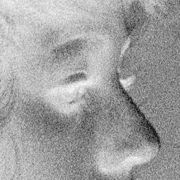<! -------Picture 1---------->

Close up objects: When photographing close objects you may need to remember depth of field, either to blur or bring the background into focus. A slow photo with a very small aperture may allow much more detail of jewellery to be photographed than a quick snapshot.
Click for a Wikipedia article about D.O.F.
http://en.wikipedia.org/wiki/Depth_of_field

"Effect of aperture on blur and DOF. The points in focus (2) project points onto the image plane (5), but points at different distances (1 and 3) project blurred images, or circles of confusion. Decreasing the aperture size (4) reduces the size of the blur circles for points not in the focused plane, so that the blurring is imperceptible, and all points are within the DOF."
Click here for further info about Depth of field on www.kevinwilley.com
<! -------Picture 2---------->

Straight from the Wikipedia article -Click here for the full story
Manual modes:
Manual modes include...
P: Program mode offers partial control over shutter speed and aperture.
Tv or S: Shutter priority controls the shutter speed, and aperture is calculated by the camera.
Av or A: Aperture priority controls the aperture, and the shutter is calculated by the camera.
M: Manual mode controls shutter speed and aperture independently.
Automatic scene modes
In automatic modes the camera determines all aspects of exposure, choosing exposure parameters according to the application within the constraints of correct exposure, including exposure, aperture, focussing, light metering, white balance, and equivalent sensitivity.
For example in portrait mode the camera would use a wider aperture to render the background out of focus, and would seek out and focus on a human face rather than other image content. In the same light conditions a smaller aperture would be used for a landscape, and recognition of faces would not be enabled for focussing.
Some cameras have tens of modes. Many cameras do not document exactly what their many modes do; for full mastery of the camera one must experiment with them.
In general:
Action or sport mode increases ISO and uses a fast shutter speed to capture action.
Landscape mode uses a small aperture to gain depth of field.
Portrait mode widens the aperture to throw the background out of focus. The camera may recognise and focus on a human face.
Night portrait mode uses an exposure long enough to capture background detail, with fill-in flash to illuminate a nearby subject.
Other scene modes found on many cameras include Fireworks, Snow, Natural light/Night snapshot, Macro/Close-up, and Movie mode.
<! -------Picture 3---------->

ISO was also covered last session last session.
A high ISO picture will probably not have as much depth of field as the same photo with a lower ISO.
<! Rule of thirds --from t3 s5 08-------->
Rule of Thirds ( from Term 3. Session 5. 2008.)
Rule of thirds The rule of thirds is a compositional rule of thumb in photography and other visual arts such as painting and design. The rule states that an image can be divided into nine equal parts by two equally-spaced horizontal lines and two equally-spaced vertical lines. The four points formed by the intersections of these lines can be used to align features in the photograph. Proponents of this technique claim that aligning a photograph with these points creates more tension, energy and interest in the photo than simply centering the feature would. http://en.wikipedia.org/wiki/Rule_of_thirds

These four show the various uses that the Rule of Thirds can be put to.

Firefox is an internet browser that can be better in many ways than Microsoft Internet Explorer. You can get firefox from Mozilla.org just click on the Firefox download button.
AVG Free Anti-Virus
 AVG Anti-Virus Free Edition "- trusted by 80 million users.
AVG Anti-Virus Free Edition "- trusted by 80 million users.Antivirus and antispyware protection for Windows available to download for free
NEW! LinkScanner® Active Surf-Shield checks web pages for threats at the only time that matters – when you’re about to click that link.
Make sure which link you are clicking on if you want the free one.


 Grainy high speed B/W film negative
Grainy high speed B/W film negative






















